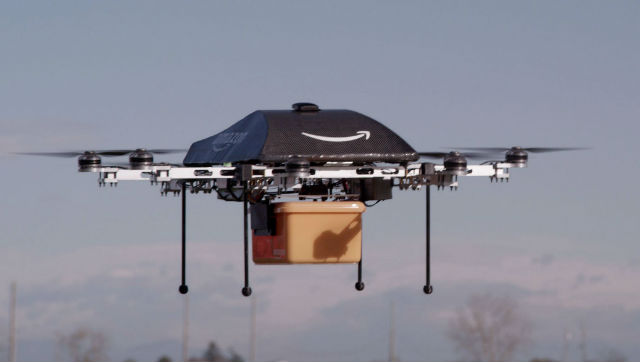A CBS 60 Minutes report on Amazon.com’s plan to deliver packages using unmanned aircraft generated plenty of publicity for the Seattle-based retailer. But the 1 December report may also help to raise public awareness for the unmanned aircraft industry, and the challenges that experts say will likely keep the company's drones grounded for the foreseeable future.
“Amazon talking about how they are going to use [unmanned aircraft] helps educate the public about what needs to be done,” says Ben Gielow, government relations manager and general council at the Association for Unmanned Vehicle Systems International (AUVSI).
The story also highlights potential “tangible benefits” offered by drones, which Gielow notes have long suffered from association with larger unmanned military aircraft, and especially the publicly-unpopular kind that drop munitions on suspected terrorists.
For years, the industry has sought to ditch the military connotation by calling pilotless aircraft unmanned air systems or unmanned air vehicles, and not drones.
Only part of 60 Minutes’ report focused on Amazon’s unmanned aircraft plan.
But those few minutes may have drawn the most attention to both the company and the news programme, which some pundits chided for giving free advertising to Amazon on the eve of Cyber Monday, a day of heavy online shopping.

Rex Features
In the 60 Minutes story, Amazon chief executive Jeffrey Bezos shows off six-propeller “hexacopters” he says could eventually carry small packages up to 10 miles, allowing the company to deliver goods in some areas within 30min of ordering.
“It will work, and it will happen,” Bezos says.
Another package delivery company, UPS, says it has evaluated using UAS, but did not elaborate. FedEx declined to "speculate about this particular technology".
Bezos concedes the technology is still in development and that regulatory hurdles will keep Amazon’s unmanned aircraft out of the sky until at least 2015. That is because, currently, a commercial operator must receive a “special airworthiness certificate” for experimental aircraft from the US Federal Aviation Administration to fly such systems in US airspace.
So far, the FAA has permitted only one company to operate UAVs in the sparse airspace of the Arctic Circle, north of Alaska, the agency tells Flightglobal.
Amazon, which did not respond to a request for comment, did not need FAA approval because it tested its drones outside the USA, the agency says. Companies today have no other choice, because the FAA's existing regulations are “extremely onerous” and “stifling” to innovation, Gielow says, although he is optimistic for the longer term.
In mid-2014 the FAA is expected to publish proposed rules that would allow the operation of small UAS in public airspace. The body is likely to require operators of such systems to retain line of sight contact with their aircraft, and operations above 400ft (121m) will likely be prohibited, Gielow predicts. He expects the FAA to finalise the rule in 2015, following a public comment period.
In addition, the FAA has said that by the end of the year it will announce the location of six new UAS test sites in the USA where private companies will be able to test aircraft. That move will speed innovation and provide the administration with data it needs to write more comprehensive UAS rules, Gielow says.
“It will help the FAA work towards more widespread integration beyond visual line-of-sight,” he says.
Though regulator hurdles may be cleared in a few years, technological challenges may still make Amazon’s plan impractical, according to Nickolas Macchiarella, chair of the aeronautical science programme at Embry-Riddle Aeronautical University in Florida.
To operate in cities, unmanned aircraft would need sophisticated navigation systems to avoid obstacles like buildings, and so-called “sense and avoid” technology to stay clear of airborne obstacles, like other manned and unmanned aircraft, Macchiarella says.
To fly in windy conditions, unmanned aircraft will likely need to be fairly hefty, perhaps weighing 22-27kg (50-60lb), which will likely make them relatively expensive, he adds.
“I’m sure the transportation cost would be higher than [the value] of the product you are carrying, unless it is an 18-karat rock,” says Macchiarella.
Source: FlightGlobal.com


























